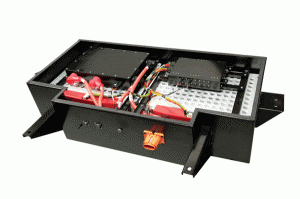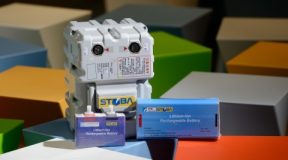Stuart Paterson, Doug Withers, Rebecca Trengove, Axeon
Over the last few years lithium-ion has become the battery chemistry of choice for the new generation of electric, hybrid and plug-in hybrid vehicles. However, manufacturing such high power batteries is considerably more complex than that of smaller packs. This article seeks to outline some of the challenges that we believe face the industry, based on our experience both as a designer and manufacturer of electric vehicle (EV) batteries and having managed the manufacture and complete system integration of batteries for several customers to their design.
The EV battery industry is still evolving and has not yet reached the levels of maturity of either consumer battery manufacture or the mainstream automotive industry. The industry still lacks real data from thousands of vehicles on the road and will continue to do for some time. In the absence of data and the standard operating procedures (SOPs) that will doubtless follow, judgements and estimations based on solid experience of EV battery manufacture will continue to be invaluable to automotive OEMs.
Design for Manufacture
 Efficient and effective manufacture of EV batteries must start with robust design for manufacture (DFM). This requires detailed understanding of both the end application (what is the proposed drive cycle of the vehicle and what power/energy inputs will be required) and cell chemistry, in order to determine which cell will be most appropriate for that application. Cells for EVs can be a variety of different form factors (prismatic, cylindrical and pouch cell) and different chemistries (including lithium-iron phosphate, lithium NCM, lithium titanate).
Efficient and effective manufacture of EV batteries must start with robust design for manufacture (DFM). This requires detailed understanding of both the end application (what is the proposed drive cycle of the vehicle and what power/energy inputs will be required) and cell chemistry, in order to determine which cell will be most appropriate for that application. Cells for EVs can be a variety of different form factors (prismatic, cylindrical and pouch cell) and different chemistries (including lithium-iron phosphate, lithium NCM, lithium titanate).
In addition, an effective battery management system (BMS) is crucial. This is the control system that monitors the state of a battery, measuring and controlling key operational parameters, and thus ensuring safety. It must be configured specifically for the chosen cell chemistry. But choosing the best cell and integrating the BMS effectively is not sufficient; mechanical engineering is also an important part of the process, ensuring that the battery is effectively packaged within the vehicle (usually with tight space constraints) and that it can safely survive the vibration regime to which vehicles are subject. Thermal management of the cells (heating/cooling) may also be required, which can introduce further challenges, e.g. the use of liquid coolants. All these add to the complexity of design of EV batteries.
All the above activity needs to consider manufacturability and in our view this is where there is currently a deficit. Not enough attention has been paid to DFM, possibly stemming from experienced designers not having battery assembly and systems integration experience. For example, the final product may be fit for purpose, but the process steps to assemble it involve considerable challenges with regard to safety and incident avoidance. Working with high voltage (HV) products demands rigorous focus on health and safety, with all personnel subject to HV DC training. Such training may need to be developed in house because of the difficulty of finding EV-specific training. Given the weight of EV batteries, it is also important to ensure enough provision for lifting and handling points. Even the order of manufacture has to be carefully considered; for some EV systems, the method in which they are powered up is key and this needs to be accommodated in the manufacturing and systems integration process. Knowledge and considerable experience of battery pack assembly enables us to advise customers of critical areas that may not be immediately obvious to those without such experience.
The biggest component of a battery is the cells. As we have previously stated, form factors and chemistries can differ markedly, with little standardization of cells even in the same type of form factor. As a cell-agnostic battery designer, and therefore with experience of working with many different types of cells, Axeon has developed a range of sophisticated joining techniques to ensure ease of manufacture as well as fitness of purpose. Welding has to meet exacting standards (we carry out more than 1.5 million resistance welds/week), and the use of dissimilar materials for interconnections has required the development of other welding techniques, including friction and laser welding. Some demanding thermal management regimes necessitate the selection, application and dispensing of thermally-conductive adhesive, placing additional burdens on the manufacturing process, as does the increasing use of exotic materials and manufacturing processes for enclosure systems.
Supply Chain Management
These rapidly-evolving techniques and the increasing demands for newer materials also place strains on the supply chain. Understanding customer needs and the drivers for different performance requirements of different applications is critical to sourcing materials and reducing lead times, particularly for prototype and development work.
Industry knowledge is required to know which suppliers have the capability and expertise to work through prototyping and development (bearing in mind that these suppliers may not be suitable for volume manufacturing), and this may drive us to look outside the traditional automotive supply chains. In itself, this is a speciality process that includes outsourcing to some key partners and developing strategic partnerships with others on key processes.
Such strategic partners include cell suppliers, and demonstrate the benefit that a deep understanding of electrochemistry brings not only to manufacture but also to supply chain management. It does this by giving cell suppliers the confidence that their manufacturing partner/customer has the experience to integrate their cells safely and effectively into robust and reliable batteries, thus ensuring the protection of their valuable brands, and also to quickly integrate newer cell technologies as they become available.
Cells are live units and are affected by environmental conditions. It is therefore imperative that during handling, storage and inventory management of both cells and finished battery systems the characteristics of the commodity in the environment is fully understood. Each cell chemistry is unique and it is vital that the appropriate environmental and monitoring systems are in place during manufacturing to ensure there is no detrimental effect to the performance.
It is important to have full traceability on cells. This is achieved using bar codes that are unique to each individual cell and that will be recorded at every part of the manufacturing process and cross-referenced to the unique serial number of the finished system. This also allows cells to be grouped into similar batches for each module or system based on their
electrical characteristics.
Manufacturing Flexibility
The current stage of the industry, with many OEMs working on prototypes, also requires flexibility of battery manufacture, in particular the ability to produce prototypes or small volume runs. Axeon’s response has been to develop a flexible production facility that can be quickly adapted. This allows us to cut down lead times and costs for proof-of-concept or small batch runs but is scaleable and can rapidly be transferred to volume production. It also enables us to incorporate new technologies very quickly as they become available.
This flexibility can accommodate build-to-print, though our experience is that currently in the EV battery industry true build-to-print doesn’t yet exist, as generally the processes and procedures to be transferred have either not been established or refined. As was noted previously, when designs go into manufacture for the first time, not all aspects of safety, reliability and design for manufacture may have been addressed, and therefore input from experienced manufacturers can add significant value by improving processes and reducing time and cost.
Quality Standards
Despite the low volumes, performing to exacting quality standards is clearly critical to automotive OEMs, who want all processes to such standards. TS16949, the main automotive standard, was developed around long-term volume manufacture and therefore is not always suitable for development work or smaller runs, where adherence to the full standard would probably produce unacceptably long lead times and prohibitive costs. A more nuanced and flexible approach, where a range of options is available to customers, has proven an effective way to work towards the standard while retaining speed of response and minimizing cost through the early development process.
For most automotive OEMs, dangerous goods regulations (demanded by the safety issues around lithium-ion batteries) are likely to be a new subject. It is therefore critical that EV battery manufacturers are fully conversant with UN transportation regulations for lithium batteries and have the appropriate trained Dangerous Goods personnel on site, including a DG Safety Adviser (DGSA). This ensures that they can meet all of the transport regulations for air, sea, road and rail freight. Meeting the regulations requires detailed knowledge of the testing regimes and is aided by DFM to ensure that the tests are passed, another example of where effective and thorough design can impact positively upon EV battery manufacture.
Conclusion
Many commentators have observed that reliable batteries are key to the EV industry developing as rapidly as forecast. Ensuring such reliability requires expertise not only in cell chemistry, electronics and mechanical engineering, but also in developing and implementing cost-effective, repeatable and safe manufacturing processes. Those with specialist knowledge and experience of overcoming some of the challenges can guide the industry and help it to achieve its potential.
Stuart Paterson and Doug Withers are respectively European operations manager and European supply chain manager for Axeon. Between them they have more than 35 years of battery manufacturing experience. Doug is also a certified Dangerous Goods Safety Adviser. Rebecca Trengove is head of Marketing and Corporate Affairs.
Axeon is a producer of Li-Ion battery systems for electric vehicles (EVs) and Hybrid electric vehicles (HEVs). Axeon’s battery and charger systems are designed and manufactured to full automotive standards, incorporating all the exacting requirements of packaging design, thermal management, electronics and vehicle integration.
For more information please visit www.axeon.com.
This article was printed in the November/December 2011 issue of Battery Power magazine.








